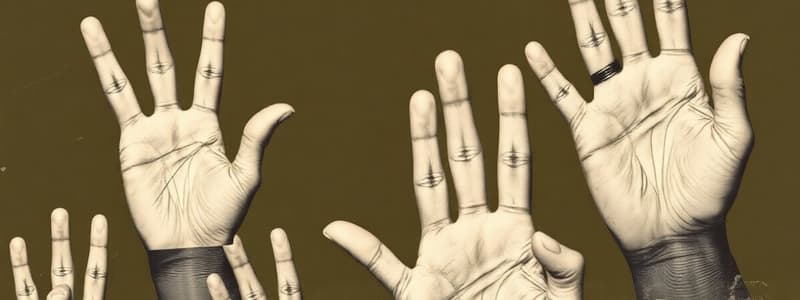Podcast
Questions and Answers
What is the main focus of the document?
What is the main focus of the document?
Learning American Sign Language (ASL) numbers from 1 to 15
What are the two fundamental aspects of ASL gestures mentioned in the document?
What are the two fundamental aspects of ASL gestures mentioned in the document?
Hand shapes and movements
Each ASL number is represented by a unique hand shape.
Each ASL number is represented by a unique hand shape.
True (A)
What is the importance of smooth transitions between signs in ASL?
What is the importance of smooth transitions between signs in ASL?
What is the recommended practice for signing the number '6' in ASL?
What is the recommended practice for signing the number '6' in ASL?
Describe the handshape used for signing the number '10'.
Describe the handshape used for signing the number '10'.
How is the number '11' signed in ASL?
How is the number '11' signed in ASL?
How should the fingers be positioned when signing the number '13' in ASL?
How should the fingers be positioned when signing the number '13' in ASL?
What is a recommended practice for mastering ASL numbers?
What is a recommended practice for mastering ASL numbers?
How does engaging with the Deaf community help in learning ASL?
How does engaging with the Deaf community help in learning ASL?
What is one key benefit of learning ASL numbers in terms of communication?
What is one key benefit of learning ASL numbers in terms of communication?
Why are ASL numbers considered basic building blocks for ASL proficiency ?
Why are ASL numbers considered basic building blocks for ASL proficiency ?
What cultural significance does understanding ASL numbers have?
What cultural significance does understanding ASL numbers have?
Flashcards
ASL Number 1
ASL Number 1
Extend index finger, palm facing you, other fingers folded.
ASL Number 2
ASL Number 2
Extend index and middle fingers like a 'V', palm facing you.
ASL Number 3
ASL Number 3
Extend index, middle, and thumb fingers, palm facing you.
ASL Number 4
ASL Number 4
Signup and view all the flashcards
ASL Number 5
ASL Number 5
Signup and view all the flashcards
ASL Number 6
ASL Number 6
Signup and view all the flashcards
ASL Number 7
ASL Number 7
Signup and view all the flashcards
ASL Number 8
ASL Number 8
Signup and view all the flashcards
ASL Number 9
ASL Number 9
Signup and view all the flashcards
ASL Number 10
ASL Number 10
Signup and view all the flashcards
ASL Number 11
ASL Number 11
Signup and view all the flashcards
ASL Number 12
ASL Number 12
Signup and view all the flashcards
ASL Number 13
ASL Number 13
Signup and view all the flashcards
ASL Number 14
ASL Number 14
Signup and view all the flashcards
ASL Number 15
ASL Number 15
Signup and view all the flashcards
Study Notes
Learning ASL Numbers 1-15
- ASL numbers are represented by unique handshapes.
- Proper handshapes are crucial for clarity and comprehension
- Smooth transitions between handshapes are important in ASL.
- Practicing fluency in signing numbers is essential for effective communication
How to Sign Numbers 1-5
- Number 1: Raise index finger, keeping other fingers folded into the palm facing you.
- Number 2: Extend index and middle fingers like a 'V', palm facing inward.
- Number 3: Extend middle, index, and thumb fingers, maintaining a natural hand posture, palm facing you.
- Number 4: Extend index, middle, ring, and pinky fingers, tucking the thumb, keeping fingers slightly open, palm facing you.
- Number 5: Use the whole hand, fingers slightly open, palm facing you.
How to Sign Numbers 6-9
- Number 6: Use dominant hand, palm facing outward, pinky finger touching the thumb, double tap.
- Number 7: Use dominant hand, palm facing outward, ring finger touching thumb, double tap.
- Number 8: Use dominant hand, palm facing outward, middle finger touching thumb, double tap.
- Number 9: Use dominant hand, palm facing outward, index finger touching thumb. Double tap (common error to confuse with letter 'F').
How to Sign Number 10
- Use dominant hand with "A" handshape. Keep the thumb straight up and show slight wiggle movements sideways.
How to Sign Numbers 11-15
- Number 11: Use dominant hand, index finger pointing up, gently flicking it slightly.
- Number 12: Use dominant hand (index & middle) pointing up, flicking it slightly to show "2".
- Number 13: Use dominant hand to show "3", ensuring all fingers are closed together and showing bend movement towards you.
- Number 14: Use dominant hand to show "4", ensuring all fingers are closed together showing bend movement towards you.
- Number 15: Use dominant hand with all closed fingers to show "5", ensuring bend movement towards you.
Practice Tips for Mastering ASL Numbers
- Regular Practice: Set aside daily time for consistent practice, focusing on both speed and clarity. Use flashcards, ASL videos, or tutoring.
- Engage with the Community: Join Deaf community events, classes, or online forums to practice with native ASL users.
Importance of Learning ASL Numbers
- Enhancing Communication: Learning ASL numbers enables individuals to express quantities, dates, times and other numerical information clearly. Enables seamless interaction between hearing and Deaf community.
- Basic Building Blocks: ASL numbers form the foundation for grasping basic ASL proficiency. Essential for more complex interactions (counting, purchasing etc.)
- Cultural Awareness: Understanding ASL numbers helps appreciate Deaf culture. Reflects respect and promotes inclusivity.
Studying That Suits You
Use AI to generate personalized quizzes and flashcards to suit your learning preferences.




